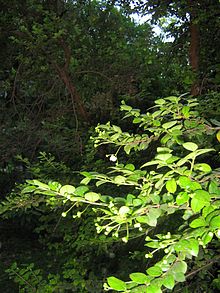| Luma | |
|---|---|

| |
|
Scientific classification
| |
| Kingdom: | Plantae |
| Clade: | Tracheophytes |
| Clade: | Angiosperms |
| Clade: | Eudicots |
| Clade: | Rosids |
| Order: | Myrtales |
| Family: | Myrtaceae |
| Subfamily: | Myrtoideae |
| Tribe: | Myrteae |
| Genus: |
Luma A.Gray |
| Synonyms [1] | |
|
Myrceugenella Kausel | |
Luma is a genus of flowering plants in the myrtle family Myrtaceae, described as a genus in 1853. [2] [3] It is native to the Valdivian temperate rain forests of Chile and Argentina. [1]
They are shrubs or small trees with evergreen foliage and smooth red or orange bark, typically reaching 10–20 m (33–66 ft) tall and up to 1 m (3 ft) in trunk diameter. The leaves are opposite, oval, 1–5 cm long and 0.5–3 cm broad, entire, glossy dark green, with a spicy scent if crushed. The flowers are 2 cm diameter with four white petals and numerous stamens; the fruit is a small purple or black berry 1 cm diameter.
The genus name derives from the Mapuche (Native American) name for a related species, Amomyrtus luma. Though it grows slowly, luma wood is very dense and durable.
Species
| Image | Scientific name | Common Name | Distribution |
|---|---|---|---|
 |
Luma apiculata (DC.) Burret, Notizbl. | Chilean myrtle, known in Spanish as Arrayán or Temu | S Chile, S Argentina; naturalized in Alpine County in California |
 |
Luma chequen (Molina) A.Gray | Chequén or Huillipeta | Central Chile; naturalized in Peru and Bolivia |
A long list of over 100 other names have been proposed in the genus, nearly all of them now regarded as members of other genera: Blepharocalyx, Eugenia, Myrceugenia, etc.
References
- ^ a b c Kew World Checklist of Selected Plant Families
- ^ Gray, Asa. 1853. Proceedings of the American Academy of Arts and Sciences 3: 52–53 description in Latin, commentary in English
- ^ Tropicos, Luma A. Gray
- ^ Burret, (Maximilian) Karl Ewald. 1941. Notizblatt des Botanischen Gartens und Museums zu Berlin-Dahlem 15: 518-542